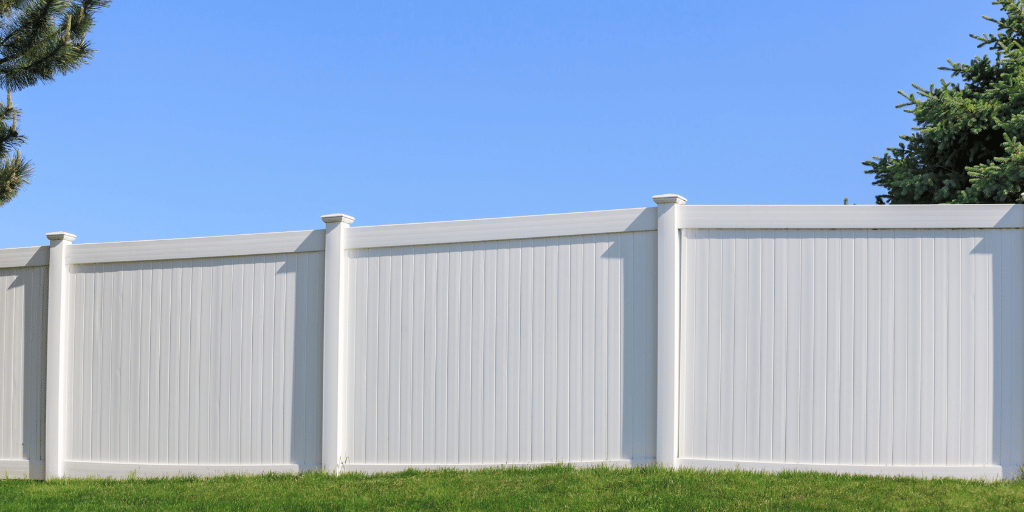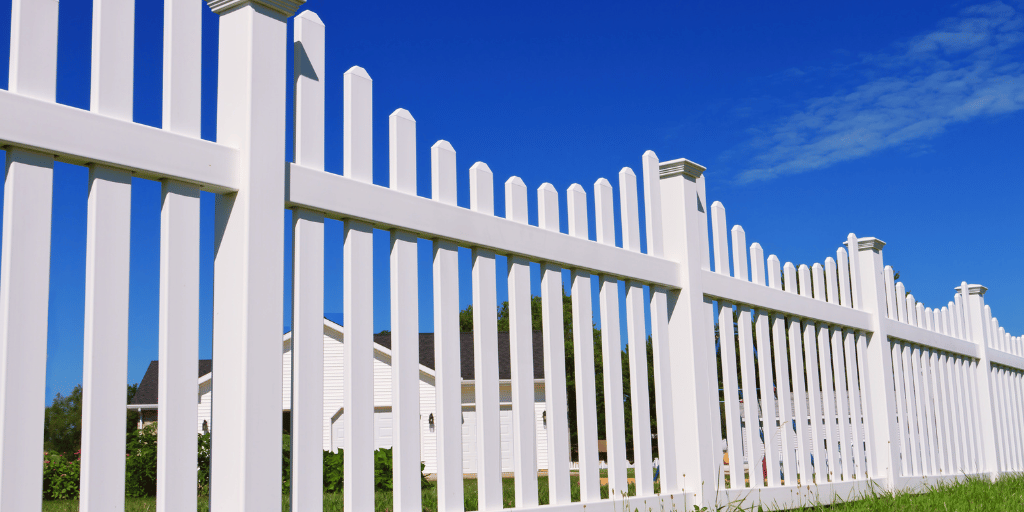Vinyl fences are popular among homeowners for their low-maintenance and durability, but over time, you might want to refresh their appearance. Unlike a wood fence, which easily absorbs stain or paint, vinyl has a non-porous surface, making it resistant to moisture and rot. However, this also means that traditional exterior paint may not adhere well, leading to peeling, chipping, or flaking over time.
If you’re considering painting your fence, it’s important to choose the right type of paint, such as acrylic or latex, and properly prepare the vinyl surface using an epoxy-based primer. With the right approach, you can give your fence a fresh look while ensuring the paint lasts longer. Let’s explore the best way to do it.
Can You Paint a Vinyl Fence?

Yes, you can paint a vinyl fence, but it’s not always the best option. Unlike a wood fence, which absorbs stain and exterior paint easily, vinyl has a non-porous surface, making it more challenging for paint to adhere properly. Without the right preparation, the paint may chip, peel, or flake over time, leading to frequent touch-ups.
If you choose to paint your vinyl fence, follow these steps:
- Clean the Surface – Use soapy water, a scrub brush, or a pressure washer to remove dirt.
- Apply an Epoxy-Based Primer – This helps the paint adhere better to the smooth vinyl surface.
- Use the Right Paint – Opt for acrylic or latex exterior paint for best results.
While painting can give your fence a new look, it requires ongoing maintenance. Before committing, consider if a low-maintenance cleaning routine is a better long-term solution.
Reasons to Reconsider Painting Your Vinyl Fence
While painting your vinyl fence is possible, it comes with challenges like peeling, chipping, and frequent upkeep, reducing its low-maintenance appeal.
Paint Adhesion Issues
One of the biggest challenges with painting a vinyl fence is its non-porous surface. Unlike wood fences, which absorb stain and paint, vinyl is designed to resist moisture, making it difficult for paint to adhere properly.
Without proper preparation, even high-quality exterior paint can struggle to bond with the vinyl surface, leading to peeling, chipping, and flaking over time. Since vinyl naturally expands and contracts with temperature changes, this movement can further weaken the coat of paint, causing cracks and premature wear.
Using an epoxy-based primer can improve adhesion, but even with the right products, painted vinyl fences require frequent maintenance—something homeowners may want to avoid when choosing a low-maintenance fencing option.
Increased Maintenance
One of the biggest advantages of vinyl fences is their low-maintenance nature. Unlike wood fences, which require regular staining or painting, vinyl is designed to stay durable with minimal upkeep. However, once you paint a vinyl fence, that benefit disappears.
Paint on a vinyl surface is prone to chipping, peeling, and fading over time, especially with exposure to harsh weather. This means you’ll need to touch up or repaint periodically to keep the fence looking fresh. Additionally, cleaning becomes more difficult, as using a pressure washer or scrubbing too aggressively can damage the coat of paint.
Instead of dealing with ongoing maintenance, many homeowners find it easier to clean their vinyl fence with soapy water and a hose to maintain its original look.
Potential Damage to the Fence
Using the wrong type of paint or skipping proper preparation can lead to more than just a poor finish—it can damage your vinyl fence. Since vinyl surfaces are non-porous, standard exterior paint won’t properly adhere, leading to peeling, flaking, or an uneven coat that makes the fence look worse than before.
Applying thick layers of paint or using the wrong primer can also trap moisture, which may cause bubbling or discoloration over time. Additionally, aggressive scrubbing or using a pressure washer to clean a painted vinyl fence can strip the coat of paint, leaving patches of the original fence color exposed.
Once painted, reversing the process isn’t easy—removing old paint can be time-consuming and may leave stains or residue, permanently affecting the fence’s appearance.
Warranty Concerns
Before you decide to paint your vinyl fence, check the manufacturer’s warranty. Many vinyl fences come with warranties that cover fading, cracking, and durability, but painting your fence often voids these protections.
Since paint may not adhere properly to vinyl surfaces, manufacturers typically don’t cover issues like peeling, chipping, or flaking caused by improper coatings. If the fence gets damaged or wears out prematurely due to painting, you may be responsible for costly repairs or replacements.
For homeowners who want a low-maintenance fencing option with long-term protection, keeping the vinyl fence in its original state is the best way to maintain warranty coverage and avoid unnecessary maintenance.
What Kind of Paint Should You Use for a Vinyl Fence?
If you decide to paint your vinyl fence, choosing the right type of paint is crucial for best results. Not all paints are designed to adhere to vinyl surfaces, and using the wrong one can lead to peeling, chipping, or flaking over time.
For long-lasting coverage, use epoxy-based acrylic paint specifically formulated for vinyl fencing. Here’s why:
- Epoxy-Based Acrylic Paint – This type of paint creates a strong bond with non-porous surfaces like vinyl, preventing peeling and chipping. It’s also flexible, allowing for natural expansion and contraction due to temperature changes.
- Acrylic Paint Over Latex or Oil-Based Paint – Standard latex paint may not fully bond with vinyl and can start to chip quickly. Oil-based paints are too rigid and prone to cracking over time.
For best results, apply an epoxy-based primer before painting to improve adhesion and durability. Using a paint sprayer will also help achieve smooth, even coverage.
Why Is It Not Necessary to Paint Your Vinyl Fencing?

One of the main reasons homeowners choose vinyl fencing is that it doesn’t require painting or staining like a wood fence. Unlike other materials, vinyl fences are designed to maintain their color, durability, and low-maintenance appeal for years without extra work.
Here’s why painting your fence is usually unnecessary:
- Durability & Color Retention – Vinyl is made with UV-resistant materials that prevent fading, so it retains its original color for decades without needing touch-ups.
- Low-Maintenance – A quick wash with soapy water and a hose keeps your fence looking clean—no paint sprayer, primer, or touch-ups required.
- No Risk of Peeling or Chipping – Since vinyl is non-porous, factory-applied colors won’t chip, peel, or flake like paint may over time.
Rather than taking on the hassle of painting your vinyl fence, homeowners can enjoy a low-maintenance fencing solution that stays looking great with minimal effort.
Alternative Options to Painting
Explore low-maintenance alternatives to painting your vinyl fence, including cleaning, staining, or upgrading for a fresh, long-lasting appearance.
Cleaning and Maintenance
Before considering painting your vinyl fence, a thorough cleaning can often restore its original look. Unlike wood fences, which require staining or painting, vinyl is a low-maintenance material that typically only needs occasional cleaning to stay in top condition.
How to Properly Clean Your Vinyl Fence:
- Use Soapy Water and a Soft Brush – Mix mild soap with water and scrub away dirt, mildew, or stains.
- Rinse with a Hose or Power Washer – A pressure washer on a low setting can remove stubborn buildup without damaging the vinyl surface.
- Spot Clean Tough Areas – For deeper stains, use a non-abrasive cleaner or diluted vinegar solution to break down grime without harming the fence.
Regular cleaning is a simple, effective alternative to painting your fence, keeping it looking new without the hassle of paint adhesion issues or increased maintenance needs.
Landscaping and Decorative Solutions
Instead of painting your vinyl fence, consider landscaping and decorative elements to improve its appearance while maintaining its low-maintenance benefits. These options can add charm and character without the risk of peeling, chipping, or flaking.
Creative Ways to Upgrade Your Fence:
- Climbing Plants & Vines – Grow ivy, roses, or wisteria along your vinyl fence for a natural, elegant touch. Use trellises for controlled growth.
- Decorative Lighting – Install solar-powered lights or string lights along the fence to create a stylish, inviting outdoor space.
- Fence Planters & Hanging Baskets – Attach colorful planters filled with flowers or greenery to add vibrancy without altering the vinyl surface.
- Privacy Screens or Lattice Panels – Incorporate lattice work or decorative panels to enhance privacy while adding visual interest.
These alternatives keep your fence looking fresh without requiring paint, primer, or ongoing maintenance, preserving its durability and original design.
Replacing Fence Panels or Sections
If your vinyl fence has severely discolored, cracked, or damaged sections, replacing individual panels is often a better solution than painting the entire fence. Unlike wood fences, which may need staining or painting to refresh their look, vinyl fences are designed for long-term durability and can be restored by swapping out affected sections.
Why Replacement Is a Better Option Than Painting:
- Preserves Low-Maintenance Benefits – New vinyl panels retain their factory-applied finish, eliminating concerns about paint adhesion issues, chipping, or peeling.
- Cost-Effective & Time-Saving – Instead of painting your fence, which requires regular upkeep, a panel replacement restores the fence’s appearance instantly with no extra maintenance.
- Seamless Look – Matching new panels to the existing fence ensures a clean, uniform finish without the risks of paint may deteriorating over time.
If sections of your fence look worn out, replacing them is a hassle-free alternative that maintains your fence’s durability and aesthetic appeal without the drawbacks of painting.
Contact a Professional for Vinyl Fence Installation & Maintenance
If you’re looking to maintain, upgrade, or install a new vinyl fence, consulting a professional fencing expert can save time and effort. At WhiteFox Fencing, we provide expert guidance on keeping your fence looking its best while preserving its low-maintenance benefits.
Why Choose Professional Installation?
- Precision & Durability – Professionally installed vinyl fences ensure a perfect fit, reducing the risk of future repairs.
- Custom Solutions – Whether you need new panels, a full replacement, or decorative enhancements, we help bring your vision to life.
- Long-Term Value – Get expert advice on fence maintenance to prevent unnecessary painting, chipping, or peeling issues.
For professional vinyl fence installation or maintenance solutions, contact us today and let our team handle the details for you!
FAQs
How Long Does Paint Typically Last on a Vinyl Fence?
Paint on a vinyl fence usually lasts 2-5 years, depending on weather exposure, paint quality, and surface preparation. However, due to vinyl’s non-porous nature, paint can chip, peel, or fade over time, requiring frequent touch-ups or complete repainting for maintenance.
Can Weather Conditions Affect the Paint on a Vinyl Fence?
Yes, extreme weather conditions like UV exposure, rain, and temperature fluctuations can cause paint to peel, fade, or crack faster. Since vinyl expands and contracts, painted surfaces may struggle to adhere properly, leading to flaking and increased maintenance needs over time.
Is It Possible to Remove Paint From a Vinyl Fence if Needed?
Yes, but removing paint from a vinyl fence can be difficult. Using a pressure washer, soapy water, and a scrub brush may help, but for stubborn paint, chemical strippers or sanding might be required, potentially damaging the vinyl surface.
Does Painting a Vinyl Fence Impact Its Warranty?
Yes, most vinyl fence warranties become void if painted. Manufacturers design vinyl fences for low maintenance, and applying paint, stain, or primer can alter the material’s properties, leading to chipping, peeling, or fading, which won’t be covered under warranty.
